Characterization and Analysis of Porosities in High Pressure Die Cast Aluminum by Using Metallography, X-Ray Radiography, and Micro-Computed Tomography
Abstract
:1. Introduction
2. Extreme Value Statistics for Defect Analysis
3. Materials and Methods
3.1. Defect Evaluation Using Metallography Examination
3.2. Defect Evaluation Using X-ray Micro-Computed Tomography
4. Defect Characterization
5. Defect Variability
5.1. Variability of Pore Size Distribution in Specimens of the Same Size and Porosity Level
5.2. Variability of Defects Size Distribution between Pre-Defined Porosity Levels
5.3. Variability of Defects between Two Specimen Sizes
5.4. Variability of Defect Size in Specimen Height and Radial Directions
6. Application of Extreme Value Statistics to Estimate the Maximum Defects
6.1. Block Maxima (BM) Approach
6.2. Peak-Over-Threshold Approach
7. Summary and Conclusions
- Cumulative probability distributions of defects based on 2D and 3D evaluations as well as the measured defects size from the fracture surfaces of the specimens at different pre-defined porosity levels suggest that the common method of X-ray radiography often used in industrial application may not be reliable for defect evaluation.
- Examining different defect characteristics in metallography examinations as well as µCT scan evaluations revealed that as the size of pores increases, they deviate more from ideal spherical (or circular in 2D) defect, indicating reduced sphericity (or circularity in 2D) of pores with increasing defect size.
- Studying the variability of defects in radial distribution revealed that the pore distribution in the specimens produced by high pressure die cast may not be random throughout the cross section, especially in large section sizes. In addition, as the casting section size increases, both the defects size and density also increase.
- Evaluating defects using µCT scan is very accurate but not always accessible, contrary to metallography approach which is accessible and cost effective while defects evaluation through metallography depends on the location of random cross section and the pores measured on metallography micrographs are smaller than those measured through µCT scan. However, increasing the number of metallography cross sections improves the accuracy of 2D measurements.
- Applying extreme value statistics to metallography data using GEV distribution function could estimate the maximum defects in reasonable agreement with the maximum observed defects on fracture surfaces. The estimate of maximum defect using POT approach to the µCT data was also in very good agreement with the maximum observed defect.
- Although EV distribution function is commonly used for estimating the maximum defect size using metallography data, the estimated maximum defect using this approach was underestimated in comparison to the maximum observed defect on fracture surfaces.
- To estimate the maximum defect size of the entire large specimen where the defects are not distributed randomly the weakest link theory was applied and the prediction of the weakest link theory was in better agreement with the maximum defect size on fracture surfaces, in comparison with the prediction using the assumption of random distribution throughout the cross section.
Author Contributions
Funding
Acknowledgments
Conflicts of Interest
References
- Hsu, Q.C.; Do, A.T. Minimum porosity formation in pressure die casting by taguchi method. Math. Probl. Eng. 2013. [Google Scholar] [CrossRef]
- Campbell, J. Complete Casting Handbook: Metal Casting Processes, Metallurgy, Techniques and Design; Butterworth-Heinemann: Oxford, UK, 2015. [Google Scholar]
- Nicoletto, G.; Konečná, R.; Fintova, S. Characterization of microshrinkage casting defects of Al–Si alloys by X-ray computed tomography and metallography. Int. J. Fatigue 2012, 41, 39–46. [Google Scholar] [CrossRef]
- Tiryakioğlu, M.; Campbell, J.; Nyahumwa, C. Fracture Surface Facets and Fatigue Life Potential of Castings. Metall. Mater. Trans. B 2011, 42, 1098–1103. [Google Scholar] [CrossRef]
- Nayhumwa, C.; Green, N.R.; Campbell, J. Influence of casting technique and hot isostatic pressing on the fatigue of an Al-7Si-Mg alloy. Metall. Mater. Trans. A 2001, 32, 349–358. [Google Scholar] [CrossRef]
- Fintova, S.; Konstantová, V.; Konečná, R.; Nicoletto, G. Experimental Study of Porosity and Fatigue Behavior af Cast Al–Si Alloys. Metal 2008, 13, 1–8. [Google Scholar]
- Ammar, H.R.; Samuel, A.M.; Samuel, F.H. Effect of casting imperfections on the fatigue life of 319-F and A356-T6 Al-Si casting alloys. Mater. Sci. Eng. A 2008, 473, 65–75. [Google Scholar] [CrossRef]
- Ruxanda, R.; Obara, R. Study case of aluminium die-cast parts with different gating conditions tested in fatigue. Int. J. Cast Met. Res. 2016, 29, 290–302. [Google Scholar] [CrossRef]
- Teng, X.; Mae, H.; Bai, Y.; Wierzbicki, T. Pore size and fracture ductility of aluminum low pressure die casting. Eng. Fract. Mech. 2009, 76, 983–996. [Google Scholar] [CrossRef]
- Eady, J.; Smith, D. The effect of porosity on the tensile properties of aluminium castings. Mater. Forum 1986, 9, 217–223. [Google Scholar]
- Kuchariková, L.; Tillová, E.; Uhríčik, M.; Belan, J. Porosity formation of AlSiCu cast alloy fatigue properties. MATEC 2018, 157, 07003. [Google Scholar] [CrossRef]
- Luetje, M.; Wicke, M.; Bacaicoa, I.; Brueckner-Foit, A.; Geisert, A.; Fehlbier, M. 3D characterization of fatigue damage mechanisms in a cast aluminum alloy using X-ray tomography. Int. J Fatigue 2017, 103, 363–370. [Google Scholar] [CrossRef]
- Boileau, J.; Allison, J. The effect of porosity size on the fatigue properties in a cast 319 aluminum alloy. SAE Trans. 2001, 110, 648–659. [Google Scholar]
- Boileau, J.; Allison, J. The effect of solidification time and heat treatment on the fatigue properties of a cast 319 aluminum alloy. Metal Mater Trans A 2003, 34, 1807–1820. [Google Scholar] [CrossRef]
- Mayer, H.; Papakyriacou, M.; Zettl, B.; Stanzl-Tschegg, S.E. Influence of porosity on the fatigue limit of die cast magnesium and aluminium alloys. Int. J. Fatigue 2003, 25, 245–256. [Google Scholar] [CrossRef]
- Wang, Q.; Apelian, D.; Lados, D.A. Fatigue behavior of A356-T6 aluminum cast alloys. Part I. Effect of casting defects. J. Light Met. 2001, 1, 73–84. [Google Scholar] [CrossRef]
- Nyahumwa, C.; Green, N.R.; Campbell, J. Effect of mold-filling turbulence on fatigue properties of cast aluminum alloys. AFS Trans. 1998, 106, 215–223. [Google Scholar]
- Zhang, B.; Poirier, D.R.; Chen, W. Microstructural effects on high-cycle fatigue-crack initiation in A356.2 casting alloy. Metall. Mater. Trans. A 1999, 30, 2659–2666. [Google Scholar] [CrossRef]
- Wang, Q.; Jones, P. Fatigue life prediction in aluminum shape castings. Int. J. Metalcasting 2014, 8, 29–38. [Google Scholar] [CrossRef]
- Shiozawa, K.; Tohda, Y.; Sun, S. Crack initiation and small fatigue crack growth behaviour of squeeze-cast Al-Si aluminium alloys. Fatigue Fract. Eng. Mater. Struct. 1997, 20, 237–247. [Google Scholar] [CrossRef]
- Skallerud, B.; Iveland, T.; Härkegård, G. Fatigue life assessment of aluminum alloys with casting defects. Eng. Fract. Mech. 1993, 44, 857–874. [Google Scholar] [CrossRef]
- Lattanzi, L.; Fabrizi, A.; Fortini, A.; Merlin, M.; Timelli, G. Effects of microstructure and casting defects on the fatigue behavior of the high-pressure die-cast AlSi9Cu3(Fe) alloy. Procedia Struct. Integr. 2017, 7, 505–512. [Google Scholar] [CrossRef]
- Radomila, K.; Nicoletto, G.; Majerova, V. Largest extreme value determination of defect size with application to cast Al-Si alloys porosity. Metal 2007, 16, 94. [Google Scholar]
- Gao, Y.X.; Yi, J.Z.; Lee, P.D.; Lindley, T.C. The effect of porosity on the fatigue life of cast aluminium-silicon alloys. Fatigue Fract. Eng. Mater. Struct. 2004, 27, 559–570. [Google Scholar] [CrossRef]
- Gall, K.; Horstemeyer, M.; Degner, B.; McDowell, D.; Fan, J. On the driving force for fatigue crack formation from inclusions and voids in a cast A356 aluminum alloy. Int J Fracture 2001, 108, 207–233. [Google Scholar] [CrossRef]
- Yi, J.; Gao, Y.; Lee, P.; Lindley, T. Effect of Fe-content on fatigue crack initiation and propagation in a cast aluminum–silicon alloy (A356–T6). Mater. Sci. Eng. A 2004, 386, 396–407. [Google Scholar] [CrossRef]
- Seniw, M.; Fine, M.; Chen, E.; Meshii, M.; Gray, J. Relation of Defect Size and Location to Fatigue Failure in Al Alloy A356 Cast Specimens; TMS: Warrendale, PA, USA, 1997. [Google Scholar]
- Wang, Q.; Jones, P.E. Prediction of Fatigue Performance in Aluminum Shape Castings Containing Defects. Metall. Mater. Trans. B 2007, 38, 615–621. [Google Scholar] [CrossRef]
- Fan, J.; McDowell, D.; Horstemeyer, M.; Gall, K. Cyclic plasticity at pores and inclusions in cast Al–Si alloys. Eng. Fract. Mech. 2003, 70, 1281–1302. [Google Scholar] [CrossRef]
- Buffiere, J.Y.; Savelli, S.; Jouneau, P.H.; Maire, E.; Fougeres, R. Experimental study of porosity and its relation to fatigue mechanisms of model Al–Si7–Mg0. 3 cast Al alloys. Mater. Sci. Eng. A 2001, 316, 115–126. [Google Scholar] [CrossRef]
- Li, P.; Lee, P.D.; Maijer, D.M.; Lindley, T.C. Quantification of the interaction within defect populations on fatigue behavior in an aluminum alloy. Acta Materialia 2009, 57, 3539–3548. [Google Scholar] [CrossRef]
- Nicoletto, G.; Anzelotti, G.; Konečná, R. X-ray computed tomography vs. metallography for pore sizing and fatigue of cast Al-alloys. Procedia Eng. 2010, 2, 547–554. [Google Scholar] [CrossRef] [Green Version]
- Ferrie, E.; Buffiere, J.Y.; Ludwig, W. 3D characterisation of the nucleation of a short fatigue crack at a pore in a cast Al alloy using high resolution synchrotron microtomography. Int. J. Fatigue 2005, 27, 1215–1220. [Google Scholar] [CrossRef]
- Garb, C.; Leitner, M.; Tauscher, M.; Weidt, M.; Brunner, R. Statistical analysis of micropore size distributions in Al-Si castings evaluated by X-ray computed tomography. Met. Res. Adv. Tech. 2018, 109, 889–899. [Google Scholar] [CrossRef]
- Leitner, M.; Garb, C.; Remes, H.; Stoschka, M. Microporosity and statistical size effect on the fatigue strength of cast aluminium alloys EN AC-45500 and 46200. Mater. Sci. Eng. A 2017, 707, 567–575. [Google Scholar] [CrossRef]
- Shirani, M.; Härkegård, G. Damage tolerant design of cast components based on defects detected by 3D X-ray computed tomography. Int. J. Fatigue 2012, 41, 188–198. [Google Scholar] [CrossRef]
- Nourian-Avval, A.; Fatemi, A. Fatigue life prediction of high pressure die cast aluminum based on porosity characteristics.Fatigue Fract. Eng. Mater. Struct. (under review).
- Murakami, Y. Metal Fatigue: Effects of Small Defects and Nonmetallic Inclusions; Elsevier: Kidlington, Oxford, UK, 2002. [Google Scholar]
- Li, Z.; Jing, Y.; Guo, H.; Sun, X.; Yu, K.; Yu, A.; Jiang, X.; Yang, X.J. Study of 3D Pores and Its Relationship with Crack Initiation Factors of Aluminum Alloy Die Castings. Metall. Mater. Trans. B 2019, 50, 1204–1212. [Google Scholar] [CrossRef]
- Zhang, Y.; Xu, J.; Zhai, T. Distributions of pore size and fatigue weak link strength in an A713 sand cast aluminum alloy. Mater. Sci. Eng. A 2010, 527, 3639–3644. [Google Scholar] [CrossRef]
- Couper, M.J.; Neeson, A.E.; Griffiths, J.R. Casting Defects and the Fatigue Behaviorpf an aluminum alloy. Fatigue Fract. Eng. Mater. Struct. 1990, 13, 213–227. [Google Scholar] [CrossRef]
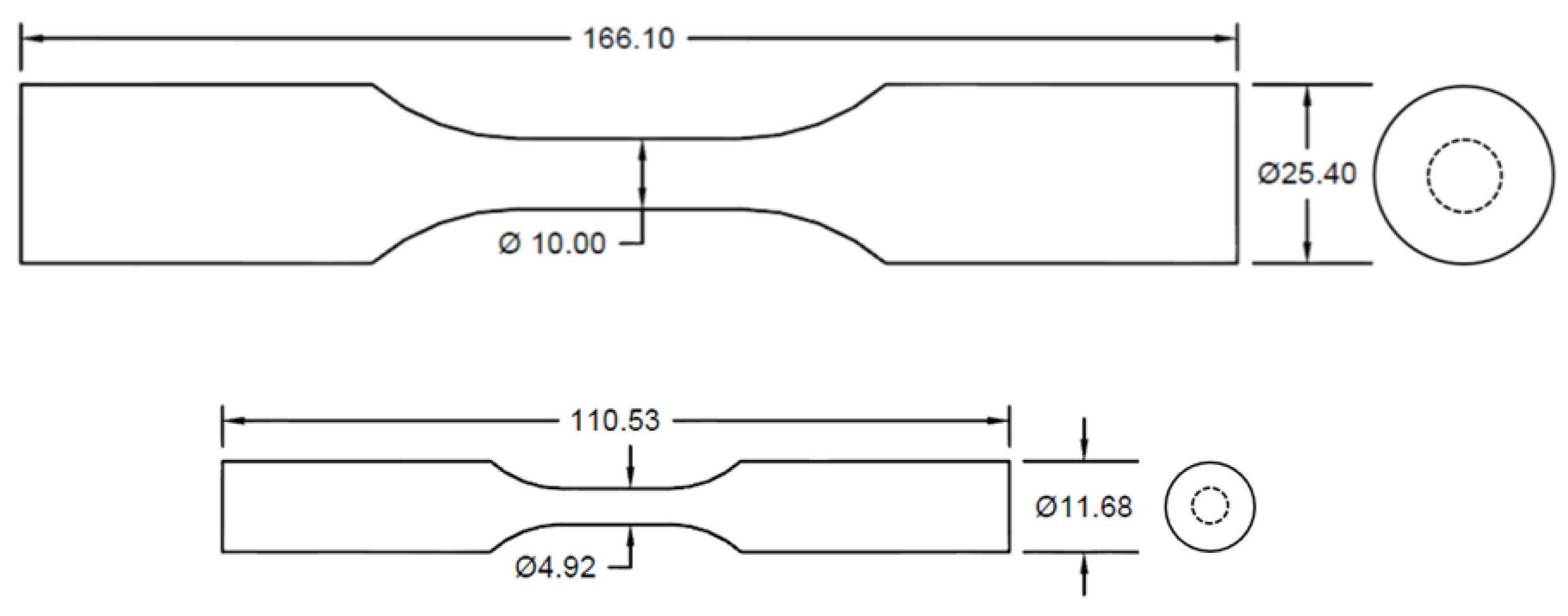
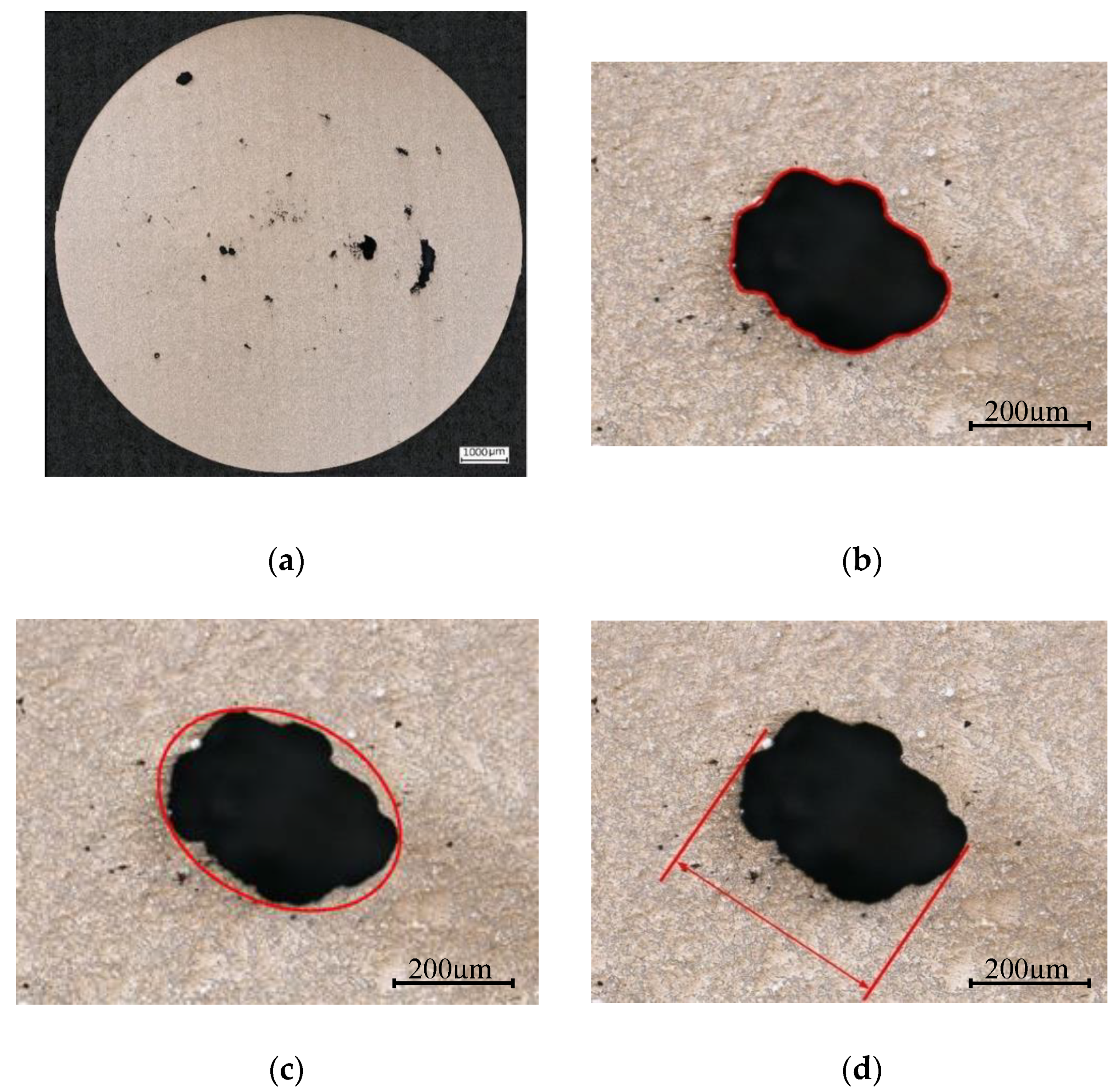

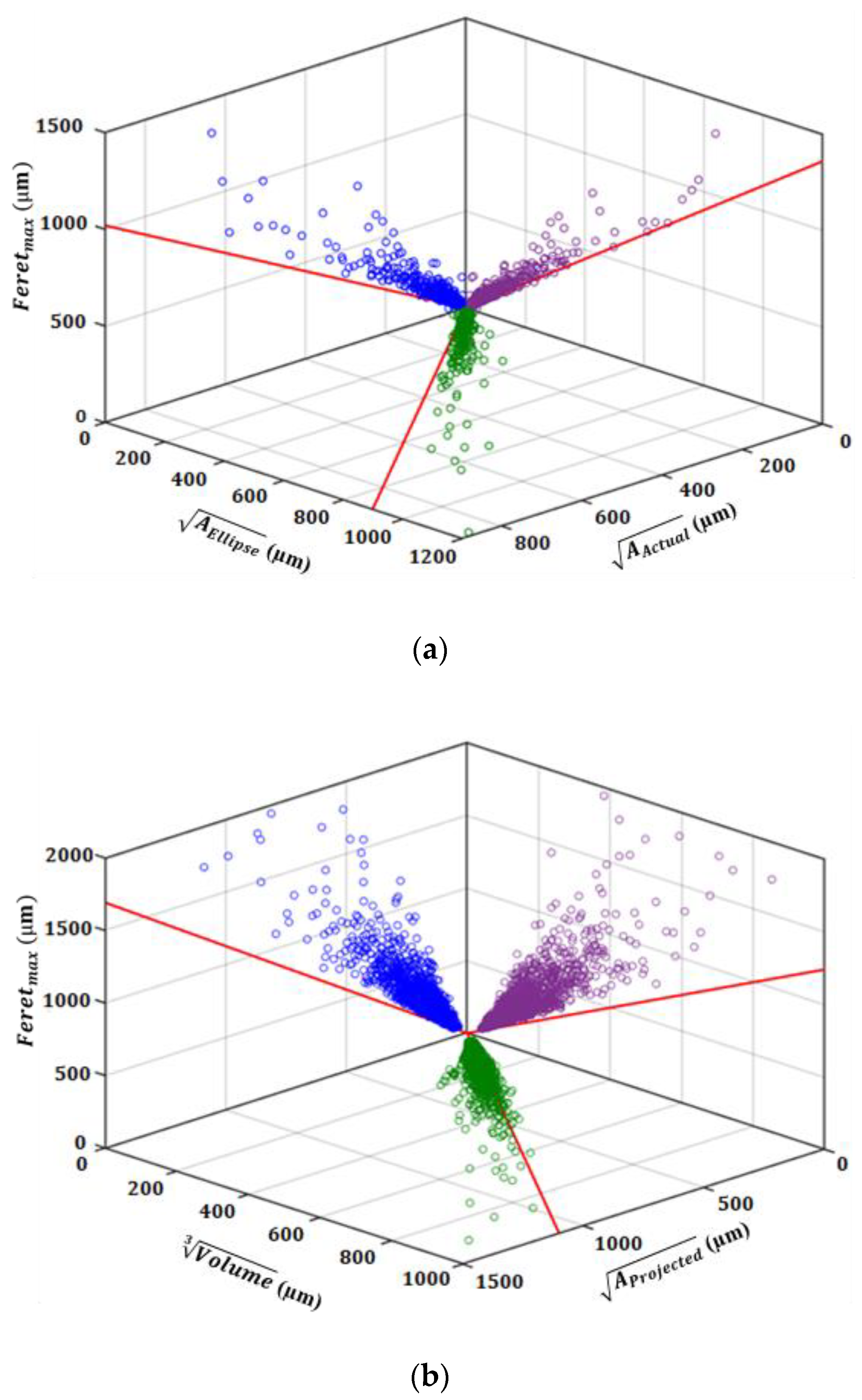

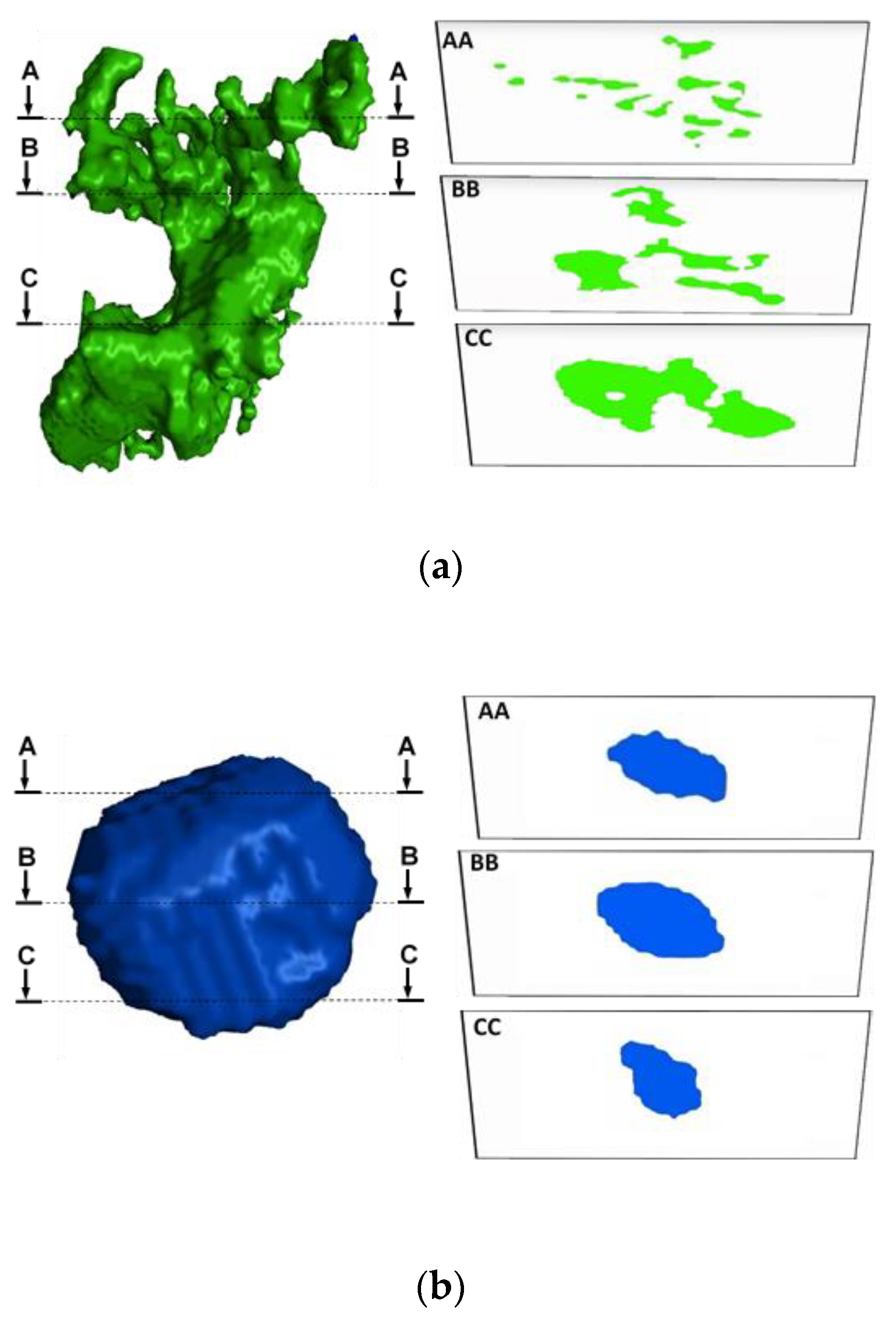




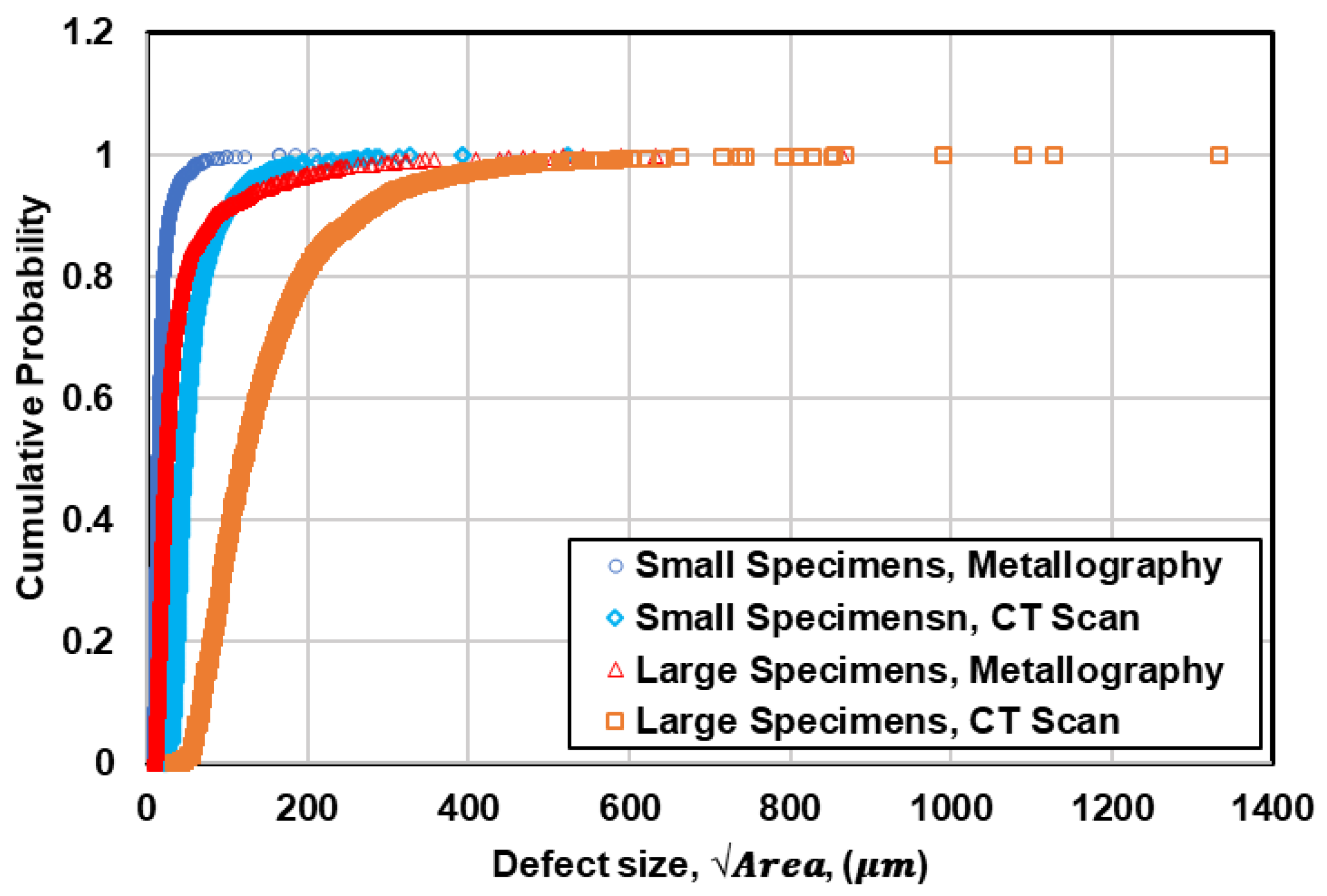
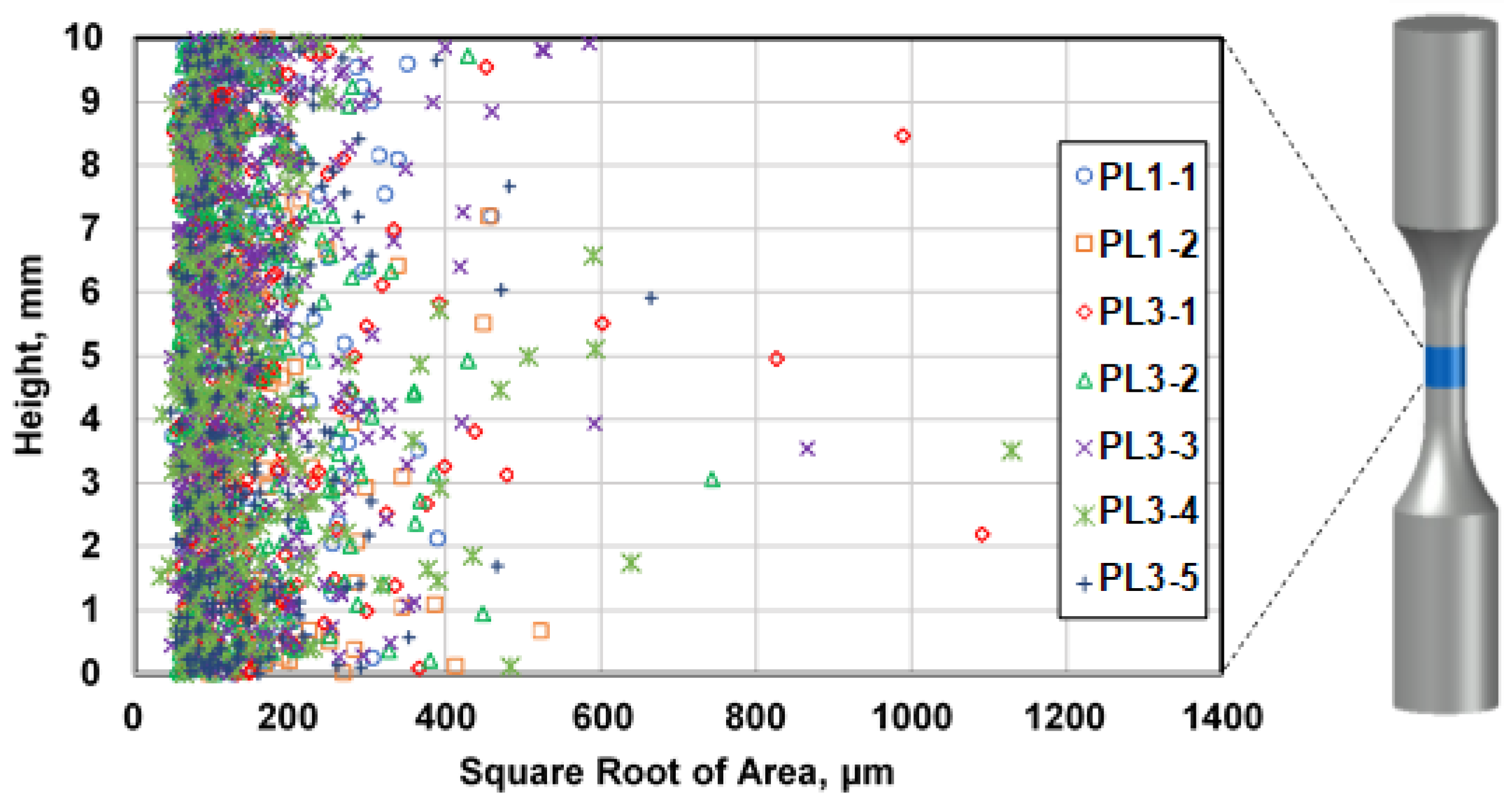

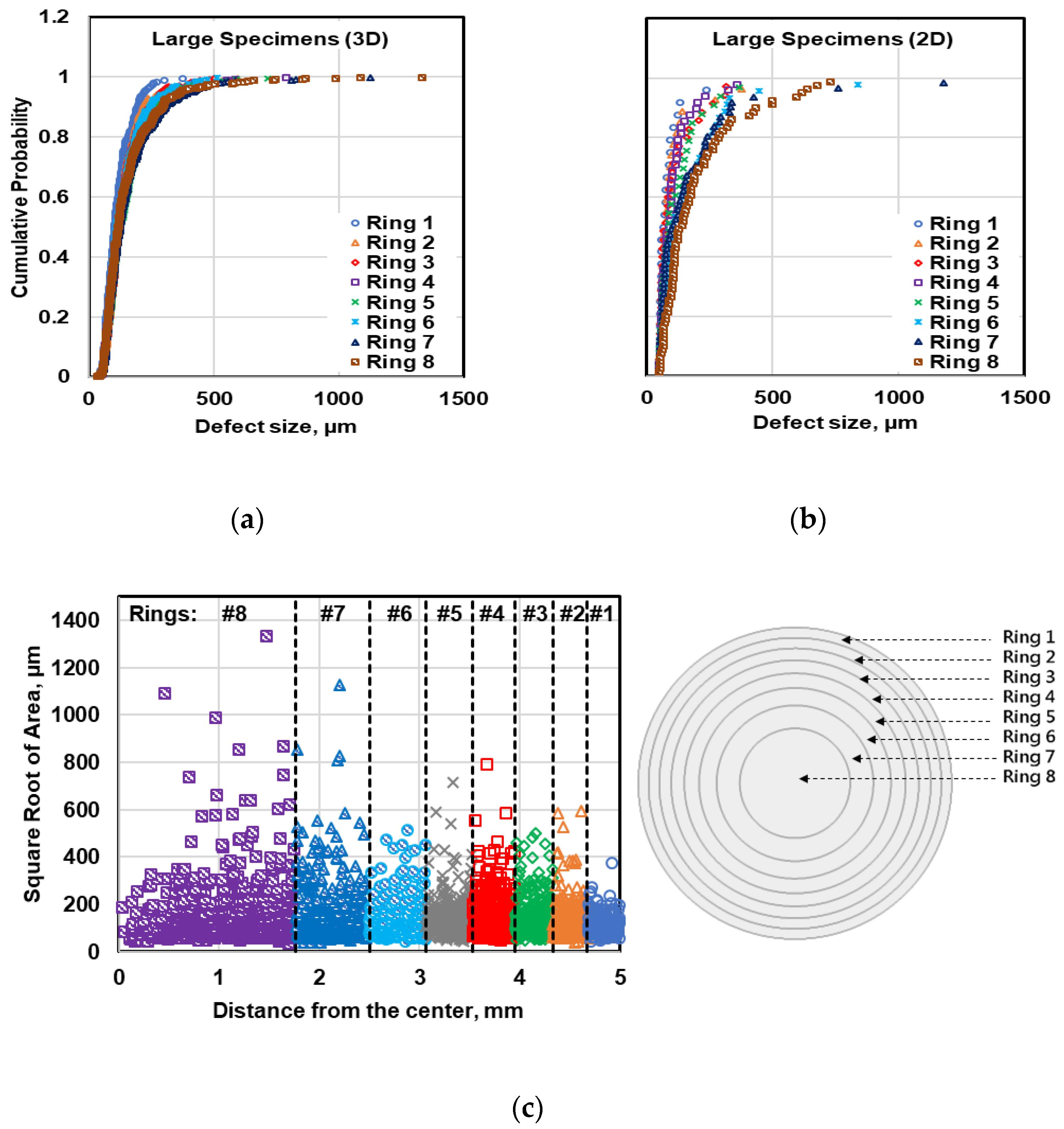
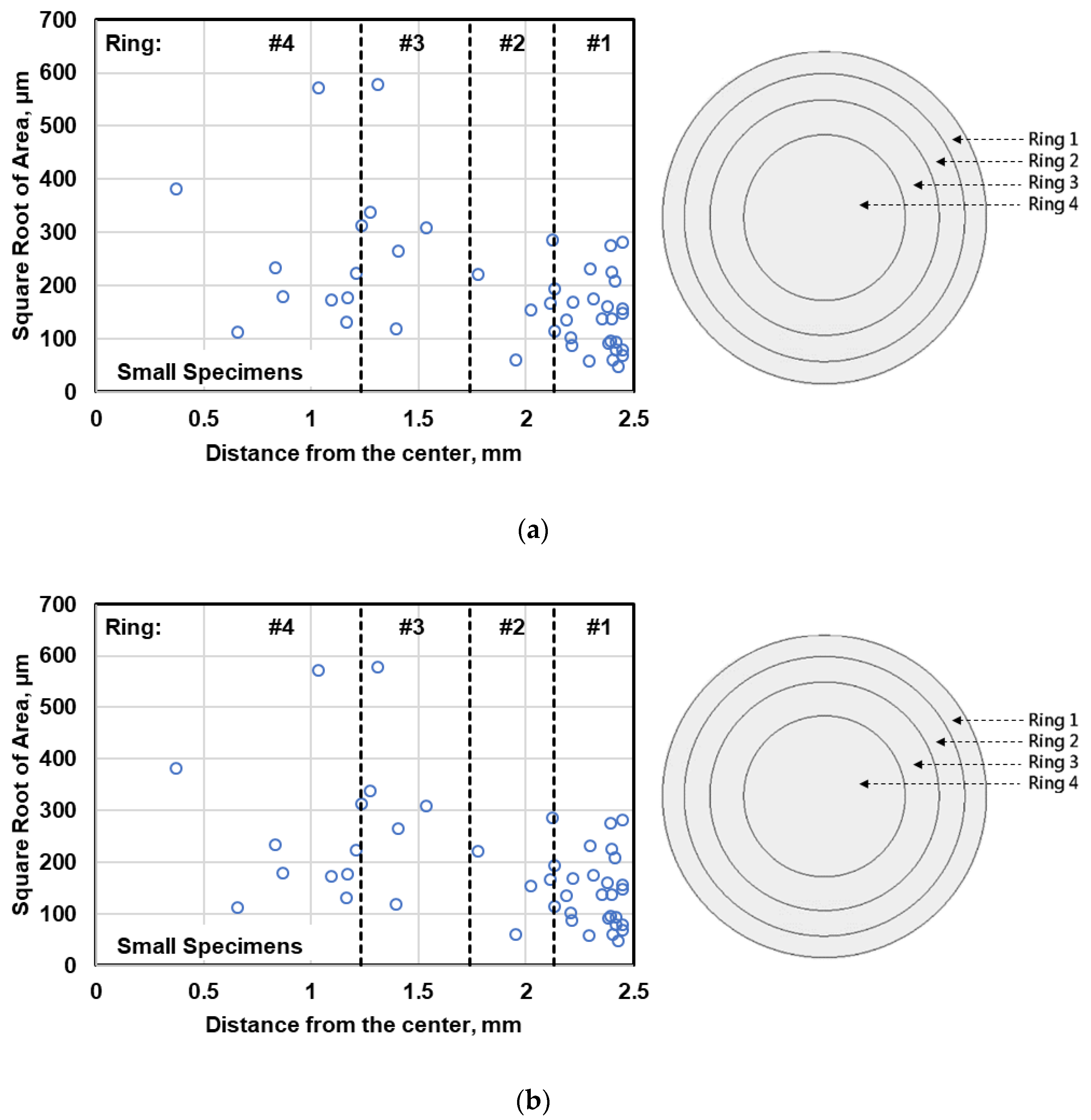
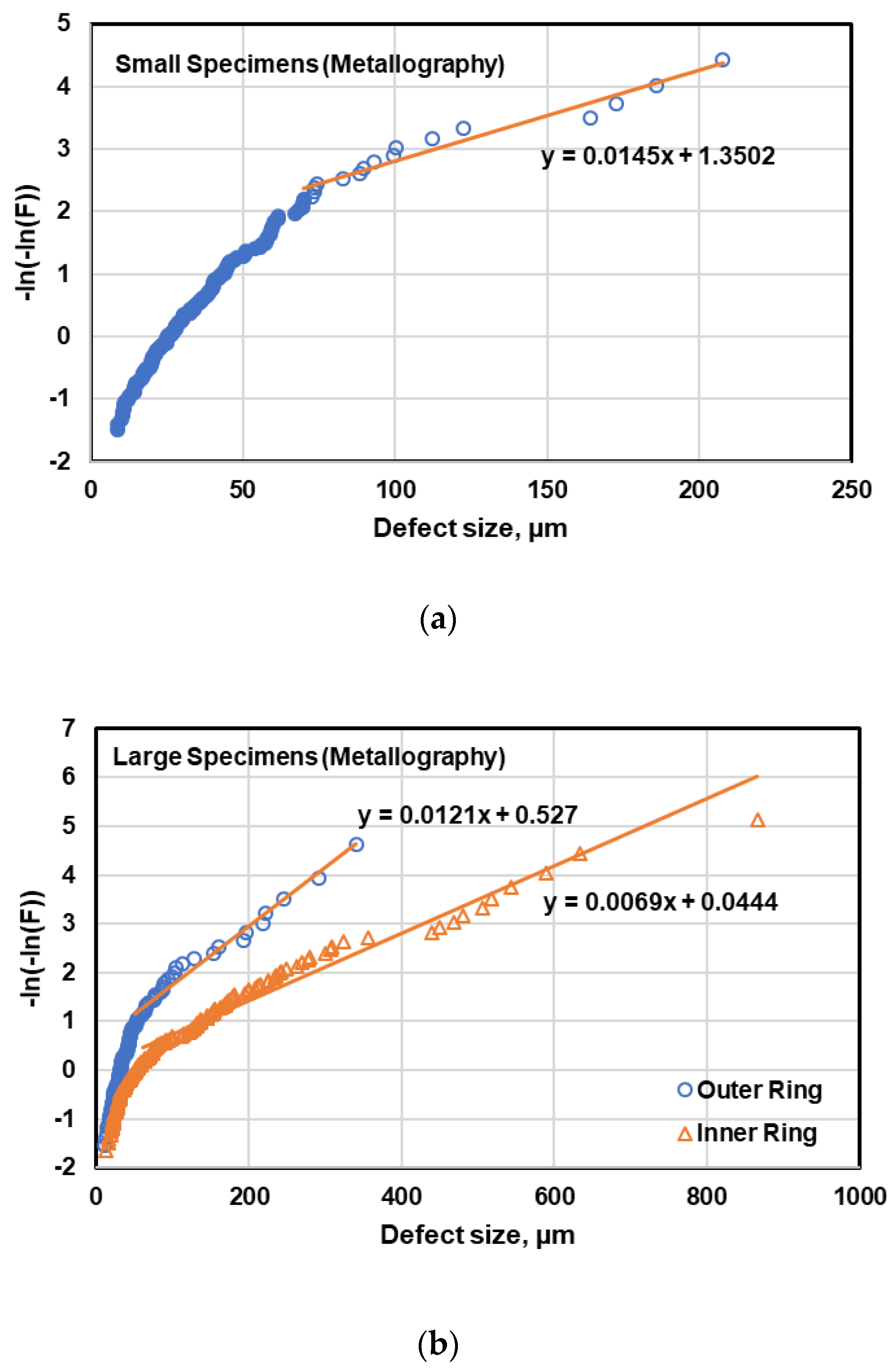

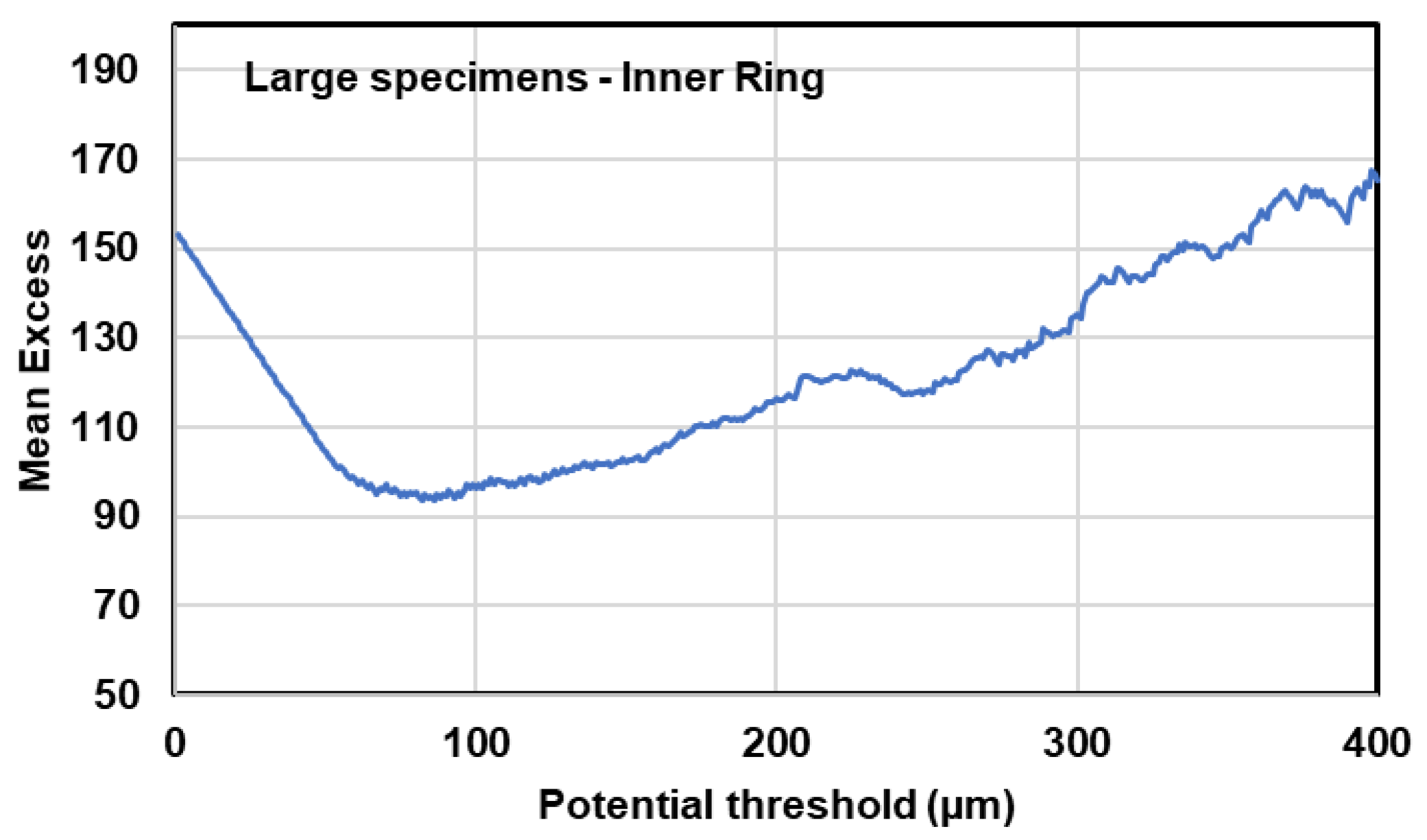
| Porosity Level | Max Defect Size (µm) | Volume Fraction of Defects (%) | |
|---|---|---|---|
| Small Specimens | Large Specimens | ||
| 1 | 0–62 | 0.013 | 0.251 |
| 2 | 63–124 | 0.010 | 0.193 |
| 3 | 125–184 | 0.021 | 0.317 |
| 4 | 185–250 | 0.018 | 0.215 |
| Method | Small Specimens | Large Specimens | ||||
|---|---|---|---|---|---|---|
| Porosity Level 1 | Porosity Level 2 | Porosity Level 3 | Porosity Level 4 | Porosity Level 1 | Porosity Level 3 | |
| Metallography | 51–173 | 59–104 | 88–207 | 112–208 | 153–234 | 589–866 |
| µCT | 175–288 | 155–167 | 243–283 | 391–522 | 461–520 | 662–1333 |
| Fracture surface | 84–463 | 67–337 | 93–578 | 47–571 | 252–1274 | 408–1141 |
| Location | Ring 1 | Ring 2 | Ring 3 | Ring 4 | Ring 5 | Ring 6 | Ring 7 | Ring 8 |
|---|---|---|---|---|---|---|---|---|
| Ring 1 | - | √ | √ | √ | √ | × | × | × |
| Ring 2 | √ | - | √ | √ | √ | √ | × | × |
| Ring 3 | √ | √ | - | √ | √ | √ | √ | × |
| Ring 4 | √ | √ | √ | - | √ | √ | √ | × |
| Ring 5 | √ | √ | √ | √ | - | √ | √ | √ |
| Ring 6 | × | √ | √ | √ | √ | - | √ | √ |
| Ring 7 | × | × | √ | √ | √ | √ | - | √ |
| Ring 8 | × | × | × | × | √ | √ | √ | - |
| Location | Ring 1 | Ring 2 | Ring 3 | Ring 4 | Ring 5 | Ring 6 | Ring 7 | Ring 8 |
|---|---|---|---|---|---|---|---|---|
| Ring 1 | - | √ | √ | × | × | × | × | × |
| Ring 2 | √ | - | √ | √ | √ | √ | × | × |
| Ring 3 | √ | √ | - | √ | √ | √ | √ | √ |
| Ring 4 | × | √ | √ | - | √ | √ | √ | √ |
| Ring 5 | × | √ | √ | √ | - | √ | √ | √ |
| Ring 6 | × | √ | √ | √ | √ | - | √ | √ |
| Ring 7 | × | × | √ | √ | √ | √ | - | √ |
| Ring 8 | × | × | √ | √ | √ | √ | - |
| Estimating Approach | Small Specimens | Large Specimens | |||
|---|---|---|---|---|---|
| Outer Ring | Inner Ring | Whole Surface | Weakest Link | ||
| GEV (2D) | 517 | 941 | 1232 | 1571 | 1362 |
| EV (2D) | 358 | 561 | 1022 | 1061 | 1113 |
| GPD (3D) | 602 | 1035 | 1303 | 1383 | 1426 |
| Observed | 578 | 963 | 1274 | 1274 | 1274 |
© 2020 by the authors. Licensee MDPI, Basel, Switzerland. This article is an open access article distributed under the terms and conditions of the Creative Commons Attribution (CC BY) license (http://creativecommons.org/licenses/by/4.0/).
Share and Cite
Nourian-Avval, A.; Fatemi, A. Characterization and Analysis of Porosities in High Pressure Die Cast Aluminum by Using Metallography, X-Ray Radiography, and Micro-Computed Tomography. Materials 2020, 13, 3068. https://doi.org/10.3390/ma13143068
Nourian-Avval A, Fatemi A. Characterization and Analysis of Porosities in High Pressure Die Cast Aluminum by Using Metallography, X-Ray Radiography, and Micro-Computed Tomography. Materials. 2020; 13(14):3068. https://doi.org/10.3390/ma13143068
Chicago/Turabian StyleNourian-Avval, Ahmad, and Ali Fatemi. 2020. "Characterization and Analysis of Porosities in High Pressure Die Cast Aluminum by Using Metallography, X-Ray Radiography, and Micro-Computed Tomography" Materials 13, no. 14: 3068. https://doi.org/10.3390/ma13143068




